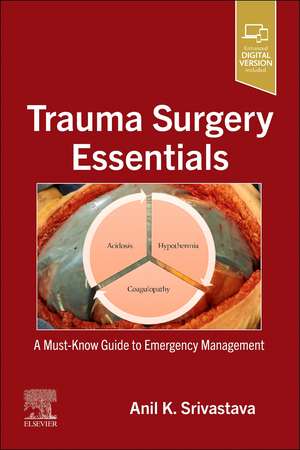Trauma Surgery Essentials: A Must-Know Guide to Emergency Management
Autor Anil K. Srivastavaen Limba Engleză Paperback – 10 aug 2023
Preț: 695.37 lei
Preț vechi: 731.98 lei
-5% Nou
Puncte Express: 1043
Preț estimativ în valută:
133.06€ • 139.30$ • 110.10£
133.06€ • 139.30$ • 110.10£
Carte disponibilă
Livrare economică 17-31 martie
Livrare express 01-07 martie pentru 43.61 lei
Preluare comenzi: 021 569.72.76
Specificații
ISBN-13: 9780323870276
ISBN-10: 0323870279
Pagini: 536
Dimensiuni: 152 x 229 x 23 mm
Greutate: 0.69 kg
Editura: Elsevier
ISBN-10: 0323870279
Pagini: 536
Dimensiuni: 152 x 229 x 23 mm
Greutate: 0.69 kg
Editura: Elsevier
Cuprins
PART A
EMERGENT EVALUATION OF THE TRAUA PATIENTS
SECTION I
INITIAL EVALUATION
Chapter 1: The Vicious cycle of trauma
Chapter 2: Death in trauma patients
Chapter 3: Process of evaluation of trauma patients
Chapter 4: Primary survey & Resuscitation
SECTION II
MANAGEMENT OF AIRWAY
Chapter 5: Definitive airway
Chapter 6: Endotracheal intubation
Chapter 7: Extra-glottic devices in failed intubation
Chapter 8: Emergency surgical airway
SECTION III
MANAGEMENT OF BREATHING
Chapter 9: Compromised Breathing & Ventilation
Chapter 10: Procedures for compromised breathing
SECTION IV
MANAGEMENT OF CIRCULATION
Chapter 11: Assessment and Management of shock
Chapter 12: Pathophysiology of hemorrhagic shock
Chapter 13: Manifestation of hemorrhagic shock
Chapter 14: Differential diagnosis of shock in trauma patients
Chapter 15: Systemic Inflammatory Response Syndrome(SIRS), Sepsis & Septic Shock
Chapter 16: Principles of management of hemorrhagic shock
Chapter 17: Access for fluid resuscitation
Chapter 18: Resuscitation fluid
Chapter 19: Balanced resuscitation
Chapter 20: Use of Blood and Blood products
Chapter 21: Control of bleeding
Chapter 22: Viscoelastic Hemostatic Assay
Chapter 23: Resuscitative Endoluminal Balloon Occlusion of Aorta (REBOA)
Chapter 24: Monitoring of Resuscitation
PART B
MANAGEMENT OF SPECIFIC TRAUMA PROBLEMS
SECTION V
MANAGEMENT OF HEAD TRAUMA
Chapter 25: Evaluation of head injury
Chapter 26: Types of brain injury
Chapter 27: Intracranial pressure monitoring
Chapter 28: Non- surgical management of traumatic brain injury
Chapter 29: Surgical management of traumatic brain injury
Chapter 30: Brain death
Chapter 31: Scalp laceration
Chapter 32: Skull fracture
Chapter 33: Facial fracture
SECTION VI
MANAGEMENT OF SPINE TRAUMA
Chapter 34: Cervical spine clearance in blunt injury
Chapter 35: Blunt cerebrovascular injury
Chapter 36: Cervical spine injuries
Chapter 37: Thoracolumbar spine injury
Chapter 38: Spinal cord injury
SECTION VII
NECK TRAUMA
Chapter 39: Blunt neck trauma
Chapter 40: Penetrating neck trauma
SECTION VIII
CHEST TRAUMA
Chapter 41: Chest wall injury
Chapter 42: Lung and tracheobronchial injury
Chapter 43: Thoracic vascular injury
Chapter 44: Esophageal injury
Chapter 45: Damage control thoracotomy
SECTION IX
ABDOMINAL TRAUMA
Chapter 46: Management of hemodynamically unstable abdominal (Blunt/Penetrating) trauma
Chapter 47: Damage control exploratory laparotomy
Chapter 48: Temporary abdominal closure
Chapter 49: Exposure of retroperitoneum
Chapter 50: Management of liver injury
Chapter 51: Management of pancreatic injury
Chapter 52: Management of spleen injury
Chapter 53 : Management of stomach injury
Chapter 54: Management of duodenal injury
Chapter 55: Management of small bowel injury
Chapter 56: Management of colorectal injury
Chapter 57: Management of retroperitoneal vascular injury
Chapter 58: Management of pelvic bleeding
Chapter 59: Management of urogenital injury
SECTION X
PERIPHERAL VASCULAR INJURY
Chapter 60: Management of upper extremity vascular injury
Chapter 61: Management of lower extremity vascular injury
SECTION XI
MUSCULOSKELETAL INJURY
Chapter 62: Management of pelvic fracture
Chapter 63: Management of extremities fractures
Chapter 64: Classification of musculoskeletal injuries
Chapter 65: Compartment syndrome
Chapter 66: Amputations
SECTION XII
MISCELLANEOUS
Chapter 67: Trauma in the extremes of age
Chapter 68: Trauma in pregnancy
Chapter 69: Scoring systems in trauma
EMERGENT EVALUATION OF THE TRAUA PATIENTS
SECTION I
INITIAL EVALUATION
Chapter 1: The Vicious cycle of trauma
Chapter 2: Death in trauma patients
Chapter 3: Process of evaluation of trauma patients
Chapter 4: Primary survey & Resuscitation
SECTION II
MANAGEMENT OF AIRWAY
Chapter 5: Definitive airway
Chapter 6: Endotracheal intubation
Chapter 7: Extra-glottic devices in failed intubation
Chapter 8: Emergency surgical airway
SECTION III
MANAGEMENT OF BREATHING
Chapter 9: Compromised Breathing & Ventilation
Chapter 10: Procedures for compromised breathing
SECTION IV
MANAGEMENT OF CIRCULATION
Chapter 11: Assessment and Management of shock
Chapter 12: Pathophysiology of hemorrhagic shock
Chapter 13: Manifestation of hemorrhagic shock
Chapter 14: Differential diagnosis of shock in trauma patients
Chapter 15: Systemic Inflammatory Response Syndrome(SIRS), Sepsis & Septic Shock
Chapter 16: Principles of management of hemorrhagic shock
Chapter 17: Access for fluid resuscitation
Chapter 18: Resuscitation fluid
Chapter 19: Balanced resuscitation
Chapter 20: Use of Blood and Blood products
Chapter 21: Control of bleeding
Chapter 22: Viscoelastic Hemostatic Assay
Chapter 23: Resuscitative Endoluminal Balloon Occlusion of Aorta (REBOA)
Chapter 24: Monitoring of Resuscitation
PART B
MANAGEMENT OF SPECIFIC TRAUMA PROBLEMS
SECTION V
MANAGEMENT OF HEAD TRAUMA
Chapter 25: Evaluation of head injury
Chapter 26: Types of brain injury
Chapter 27: Intracranial pressure monitoring
Chapter 28: Non- surgical management of traumatic brain injury
Chapter 29: Surgical management of traumatic brain injury
Chapter 30: Brain death
Chapter 31: Scalp laceration
Chapter 32: Skull fracture
Chapter 33: Facial fracture
SECTION VI
MANAGEMENT OF SPINE TRAUMA
Chapter 34: Cervical spine clearance in blunt injury
Chapter 35: Blunt cerebrovascular injury
Chapter 36: Cervical spine injuries
Chapter 37: Thoracolumbar spine injury
Chapter 38: Spinal cord injury
SECTION VII
NECK TRAUMA
Chapter 39: Blunt neck trauma
Chapter 40: Penetrating neck trauma
SECTION VIII
CHEST TRAUMA
Chapter 41: Chest wall injury
Chapter 42: Lung and tracheobronchial injury
Chapter 43: Thoracic vascular injury
Chapter 44: Esophageal injury
Chapter 45: Damage control thoracotomy
SECTION IX
ABDOMINAL TRAUMA
Chapter 46: Management of hemodynamically unstable abdominal (Blunt/Penetrating) trauma
Chapter 47: Damage control exploratory laparotomy
Chapter 48: Temporary abdominal closure
Chapter 49: Exposure of retroperitoneum
Chapter 50: Management of liver injury
Chapter 51: Management of pancreatic injury
Chapter 52: Management of spleen injury
Chapter 53 : Management of stomach injury
Chapter 54: Management of duodenal injury
Chapter 55: Management of small bowel injury
Chapter 56: Management of colorectal injury
Chapter 57: Management of retroperitoneal vascular injury
Chapter 58: Management of pelvic bleeding
Chapter 59: Management of urogenital injury
SECTION X
PERIPHERAL VASCULAR INJURY
Chapter 60: Management of upper extremity vascular injury
Chapter 61: Management of lower extremity vascular injury
SECTION XI
MUSCULOSKELETAL INJURY
Chapter 62: Management of pelvic fracture
Chapter 63: Management of extremities fractures
Chapter 64: Classification of musculoskeletal injuries
Chapter 65: Compartment syndrome
Chapter 66: Amputations
SECTION XII
MISCELLANEOUS
Chapter 67: Trauma in the extremes of age
Chapter 68: Trauma in pregnancy
Chapter 69: Scoring systems in trauma

























